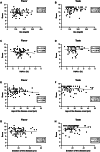Flavor and taste recognition impairments in people with type 1 diabetes
- PMID: 39095342
- PMCID: PMC11297142
- DOI: 10.1038/s41387-024-00322-1
Flavor and taste recognition impairments in people with type 1 diabetes
Abstract
Background/objectives: Adherence to dietary recommendations is a critical component in the management of type 1 diabetes (T1D). Taste and flavor significantly influence food choices. The aim of this study was to investigate taste sensitivity and flavor recognition ability in adults with T1D compared to healthy individuals.
Subjects/methods: Seventy-two people with T1D and 72 matched healthy controls participated in the study. Participants underwent the gustometry test for sweet, sour, salty, and bitter tastes and the flavor test, which consisted of oral administration of aqueous aromatic solutions identifying 21 different compounds.
Results: Participants with T1D had significantly lower flavor scores and gustometry scores than controls (p < 0.0001 and p = 0.0063, respectively). T1D individuals showed a lower perception of sour, bitter and salty tastes than controls, while the perception of sweet taste was similar. The sex differences and age-related decline in flavor perception observed in controls were not present in the participants with T1D. Neither BMI nor disease-related parameters such as fasting blood glucose on the day of the study, glycosylated hemoglobin, age at onset of diabetes, duration of diabetes, or type of insulin treatment (insulin pump or multiple daily injections) correlated with flavor and taste perception in the T1D participants.
Conclusions: Flavor and taste perception are impaired in adults with T1D, potentially affecting dietary adherence and food choices. This highlights the need for further research into the mechanisms underlying sensory changes in T1D and emphasizes the importance of targeted dietary interventions to improve health outcomes and quality of life in this population.
© 2024. The Author(s).
Conflict of interest statement
The authors declare no competing interests.
Figures




References
Publication types
MeSH terms
Substances
Grants and funding
LinkOut - more resources
Full Text Sources
Medical

